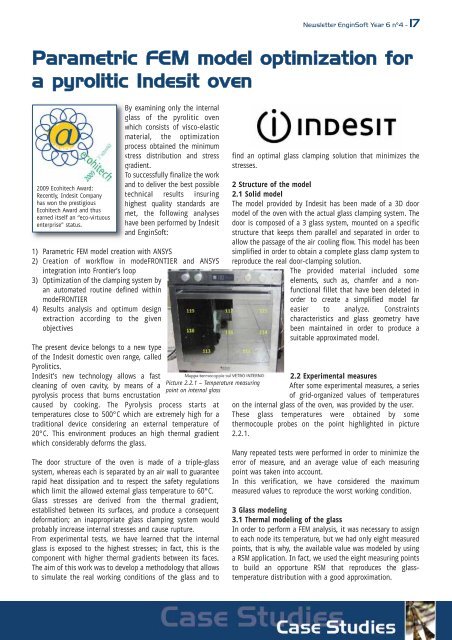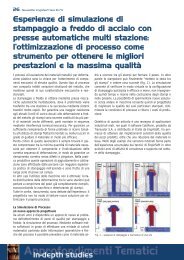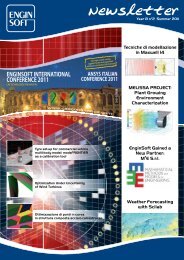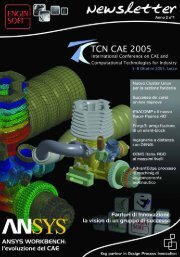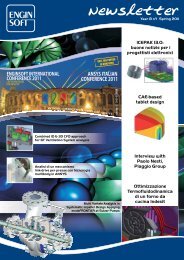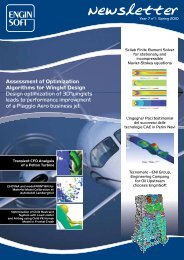software training courses 2010 corsi di addestramento ... - EnginSoft
software training courses 2010 corsi di addestramento ... - EnginSoft
software training courses 2010 corsi di addestramento ... - EnginSoft
You also want an ePaper? Increase the reach of your titles
YUMPU automatically turns print PDFs into web optimized ePapers that Google loves.
Newsletter <strong>EnginSoft</strong> Year 6 n°4 - 17<br />
Parametric FEM model optimization for<br />
a pyrolitic Indesit oven<br />
2009 Ecohitech Award:<br />
Recently, Indesit Company<br />
has won the prestigious<br />
Ecohitech Award and thus<br />
earned itself an “eco-virtuous<br />
enterprise" status.<br />
By examining only the internal<br />
glass of the pyrolitic oven<br />
which consists of visco-elastic<br />
material, the optimization<br />
process obtained the minimum<br />
stress <strong>di</strong>stribution and stress<br />
gra<strong>di</strong>ent.<br />
To successfully finalize the work<br />
and to deliver the best possible<br />
technical results insuring<br />
highest quality standards are<br />
met, the following analyses<br />
have been performed by Indesit<br />
and <strong>EnginSoft</strong>:<br />
1) Parametric FEM model creation with ANSYS<br />
2) Creation of workflow in modeFRONTIER and ANSYS<br />
integration into Frontier’s loop<br />
3) Optimization of the clamping system by<br />
an automated routine defined within<br />
modeFRONTIER<br />
4) Results analysis and optimum design<br />
extraction accor<strong>di</strong>ng to the given<br />
objectives<br />
The present device belongs to a new type<br />
of the Indesit domestic oven range, called<br />
Pyrolitics.<br />
Indesit’s new technology allows a fast<br />
cleaning of oven cavity, by means of a<br />
pyrolysis process that burns encrustation<br />
Picture 2.2.1 – Temperature measuring<br />
point on internal glass<br />
caused by cooking. The Pyrolysis process starts at<br />
temperatures close to 500°C which are extremely high for a<br />
tra<strong>di</strong>tional device considering an external temperature of<br />
20°C. This environment produces an high thermal gra<strong>di</strong>ent<br />
which considerably deforms the glass.<br />
The door structure of the oven is made of a triple-glass<br />
system, whereas each is separated by an air wall to guarantee<br />
rapid heat <strong>di</strong>ssipation and to respect the safety regulations<br />
which limit the allowed external glass temperature to 60°C.<br />
Glass stresses are derived from the thermal gra<strong>di</strong>ent,<br />
established between its surfaces, and produce a consequent<br />
deformation; an inappropriate glass clamping system would<br />
probably increase internal stresses and cause rupture.<br />
From experimental tests, we have learned that the internal<br />
glass is exposed to the highest stresses; in fact, this is the<br />
component with higher thermal gra<strong>di</strong>ents between its faces.<br />
The aim of this work was to develop a methodology that allows<br />
to simulate the real working con<strong>di</strong>tions of the glass and to<br />
find an optimal glass clamping solution that minimizes the<br />
stresses.<br />
2 Structure of the model<br />
2.1 Solid model<br />
The model provided by Indesit has been made of a 3D door<br />
model of the oven with the actual glass clamping system. The<br />
door is composed of a 3 glass system, mounted on a specific<br />
structure that keeps them parallel and separated in order to<br />
allow the passage of the air cooling flow. This model has been<br />
simplified in order to obtain a complete glass clamp system to<br />
reproduce the real door-clamping solution.<br />
The provided material included some<br />
elements, such as, chamfer and a nonfunctional<br />
fillet that have been deleted in<br />
order to create a simplified model far<br />
easier to analyze. Constraints<br />
characteristics and glass geometry have<br />
been maintained in order to produce a<br />
suitable approximated model.<br />
2.2 Experimental measures<br />
After some experimental measures, a series<br />
of grid-organized values of temperatures<br />
on the internal glass of the oven, was provided by the user.<br />
These glass temperatures were obtained by some<br />
thermocouple probes on the point highlighted in picture<br />
2.2.1.<br />
Many repeated tests were performed in order to minimize the<br />
error of measure, and an average value of each measuring<br />
point was taken into account.<br />
In this verification, we have considered the maximum<br />
measured values to reproduce the worst working con<strong>di</strong>tion.<br />
3 Glass modeling<br />
3.1 Thermal modeling of the glass<br />
In order to perform a FEM analysis, it was necessary to assign<br />
to each node its temperature, but we had only eight measured<br />
points, that is why, the available value was modeled by using<br />
a RSM application. In fact, we used the eight measuring points<br />
to build an opportune RSM that reproduces the glasstemperature<br />
<strong>di</strong>stribution with a good approximation.


